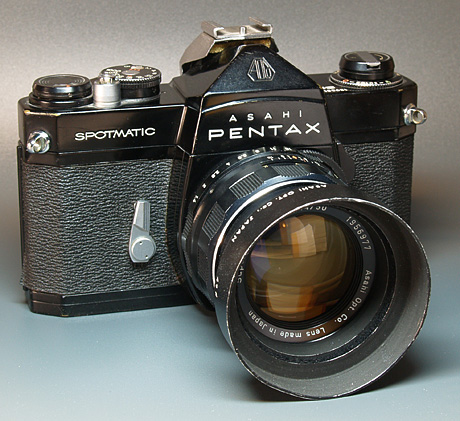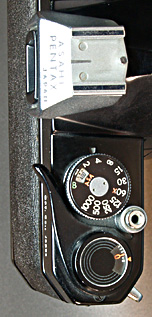
The Original Spotmatic which is introduced to the public at the 1960 Photokina, the photographic world's fair in Cologne, Germany. This was my first system camera. Very didactic but much more easy to use than my earlier camera Praktica FX. (which actually was my fathers) They belong to totally distinct classes of cameras. Spotmatic has an integrated exposure meter, not a spotmeter as you may assume, but a CdS-cell center weighted TTL meter. When you want to take a picture the first thing is to set the focus and then you, using the shutter speed and aperture rings, match the needles on the right side of the viewfinder. Compensation of back light etc. is easy to do. A high class professional camera, should I say. The Super Takumar lenses were considered as High End products and they still are very coveted items at least by the collectors. The Pentax System contained a large variety of different lenses and accessories for special scientific and medical purposes. All this at a quite reasonable price. Rumors are heard that Spotmatic is the best sold system camera in the world and it was also the first one with Through The Lens metering. "Take a hold on Pentax and it takes hold on you". Personally I must confess that the best pictures I have ever taken have been shot with Spotmatic. Personal opinion, of course. Somebody could justly ask, is the use of "best pictures" justified at all, concerning pictures taken by me?Asahi Kogaku Goshi Kaisha a forerunner of Asahi Optical Company, Ltd was established in 1919 in Tokyo by Kumao Kajiwara for a manufacturing of optical lenses. Soon was also cameras added to its line of products. In 1943 the company was a major supplier of lenses for other camera manufacturers, like Minolta and Konishiroku (Konica). During the war, most of the factories where destroyed but in 1948 Asahi Optical Company got a new start, first with manufacturing binoculars for export and later famous Pentax cameras. |
|||||||||||||||||||||||||||||||||||||||||||||||||||||||||||||||||

Specifications briefly
|
|||||||||||||||||||||||||||||||||||||||||||||||||||||||||||||||||
|
Thirty years later... Pentax MZ-5n / ZX- 5n (1997) I spite of it's progressive features MZ-5n has a rather old fashioned look. All the dials and levers and some buttons are on the "right" places. The only missing is a film rewind lever, because the job is done by a motor and can be done manually by pushing a knob.
Retro or classic or whatever, it is stylish, convenient and easy. You see what you are doing without scrambling through the menus and dials. Most of the settings can be read out and done without switching the camera on.
|
|||||||||||||||||||||||||||||||||||||||||||||||||||||||||||||||||
Pentax and Nikon has one very respectable common feature. Both cameras have a downwards compatible lens mount. Old manual K-mount lenses can be used on this camera with a cost of loosing the autofocus. How to use a manual-focus lens: |
How to focus: 1. Set the focus mode switch to [ MF ]. 2. While looking through the viewfinder, turn the focusing ring to the right or left while holding the shutter release button halfway down. 3. When the subject comes into focus, the in-focus indicator mark lights up in the viewfinder. Depress the shutter release button fully to take the picture. |
||||||||||||||||||||||||||||||||||||||||||||||||||||||||||||||||
|
|||||||||||||||||||||||||||||||||||||||||||||||||||||||||||||||||


